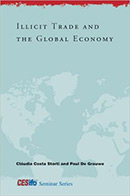Illicit Trade and the Global Economy
 Authors: C. Costa Storti and P. De Grauwe, eds.
Authors: C. Costa Storti and P. De Grauwe, eds.
Publisher: Cambridge, MA: MIT Press, 2012. 266p.
Reviewer: Leonid Lantsman│January 2013
The success of the illicit trade in goods and commodities stems, in part, from the ability of traffickers to navigate the complex supply and demand dynamics of producer and consumer markets. However, while the supply and demand strictures of illicit commodities may be well understood by organized criminal groups and transnational criminal networks, academics and security stakeholders have had less success in deciphering the hidden dynamics of illicit markets. The contributors to Illicit Trade and the Global Economy seek to remedy this lack of empirical knowledge about the supply and demand dynamics of illicit commodities. Along the way contributors explore different facets of illicit trade that illuminate how dynamic and simultaneously global and local, illicit trade has become in the modern world.
The volume, edited by Cláudia Costa Storti and Paul de Grauwe, features papers presented at a 2008 CESifo workshop titled “Globalization and Illicit Trade.” The contributions are varied and focus on numerous aspects of illicit trade, but one of the theoretical threads throughout the volume is the need identified by contributors to measure the scope and proceeds of illicit markets and transfers, and why certain paradoxes of illicit trade continue to persist despite heavy enforcement efforts. Peter Reuters and Jonathan Caulkins’ study (Chapter 2), focuses on the paradoxical inverse relationship between the rise of drug purity in distribution markets and simultaneously dropping prices.They propose that the sorting effect driving atypical population members into the drug trade leads to the continuation of this long standing puzzle. Cláudia Costa Storti and Paul De Grauwe (Chapter 6) examine the purity paradox along with the numerous ways that globalization affects drug markets. They determine that there is a market structure effect, a risk premium effect, and an efficiency effect of globalization. Globalization, in their model, tends to lower the intermediary costs of transportation and distribution and leads to lower costs for customers. By focusing on both the supply and demand side of policy, they provide support for the contention that by increasing the price of drugs, consumption would consequently decrease.
Chapters 3 and 4 focus on the transnational characteristics of illicit trade by exploring official trade data to respectively estimate the extent of money laundering and identify patterns of smuggling. Friedrich Schneider mines official Organisation for Economic Cooperation and Development data to develop a preliminary estimate of the high levels of proceeds from organized crime activity. Helge Berger and Volker Nitsch correspondingly examine official trade data, by focusing on trade discrepancies and find that reporting gaps in bilateral trade are associated with corruption levels in the reporting country. High levels of corruption lead to discrepancies of trade reporting and concurrently higher levels of smuggling such as those examined by Mohamed Reza Farzanegan in his study focusing on the structural conditions leading to the high level of smuggled goods in Iran (Chapter 5). The deeper and wider spread economic effects of organized crime are explained in detailed by Vittoria Daniele and UgoMarani (Chapter 9) in the Italian context. They find that a widespread presence of crime, particularly organized crime, lowers levels of foreign direct investment, further weakening already troubled economic regions and economic sectors.
While many of these studies focus on identifying the effects of transnational organized crime through official data sources, and then corresponding effects in country case studies, several studies incorporate qualitative methods to examine in further detail aspects of narcotics markets that are not readily inherent through statistical analysis. Kevin Walsh, Laura Wilson, and Rachel Kenehan use interviews with convicted drug trafficking in the U.K. to examine the globalization effects identified in Chapter 6. Importantly the effects of globalization are corroborated, in part, by convicted traffickers in the UK. Axel Klein’s study (Chapter 8) focuses on the differing drug control strategies related to the spread of khat, a narcotic substance grown primarily in East Africa and the southern Arabian peninsula. The complex effects of drug control strategies in the U.S. and the U.K. have led to increasingly difficult economic and societal impacts in producer countries, with little effect on consumption in the developed world. Finally, Daniel Mejía and Pascual Restrepo support Klein’s study by creating an analytical model that incorporates drug control policies in both producer and consumer countries to account for the interaction between the primary actors in the war on drugs.
The studies in this volume do much to expand our understanding of the way that globalization interacts with local societal circumstances. For example, the criminalization of a substance in a marginal consumption country, such as khat in the U.S., stems from a global anti-drug agenda that in turn affects small farmer livelihoods in East Africa. These varied effects, spoken about at length since the end of the Cold War as the tropes of globalization, take on an increasingly important role in not only the societies of consumption countries but also the economic and social well-being of producer countries and regions.
While the contributions are cogent and well supported with empirical evidence, the volume, however, can be criticized primarily in the flow of the contributions. As a compilation of seminar proceedings, the flow of the contributions does not have a completely coherent thread, and perhaps the introduction could have done more to fully integrate the varied proceedings included in the volume. Nevertheless, the book is a valuable addition to those interested in economic and qualitative analyses of the effects of globalization on the transnational trade of illicit commodities.
Leonid Lantsman, Graduate Center-City University of New York/John Jay College of Criminal Justice


